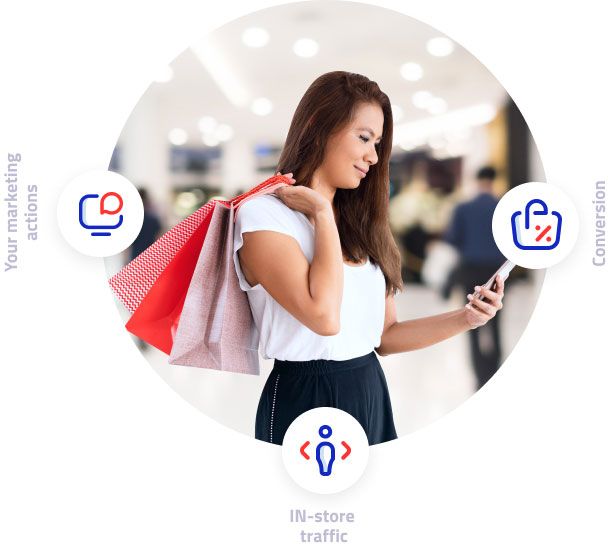They trust
us






A smart and comprehensive technology
It’s simple, think of us as the ultimate analytics solution for your physical stores bridging the gap with digital
We capture highly qualified data on your customers in real time from your surveillance cameras, videos and images or from ou rown hardware installed at your premises.
We capture highly qualified data on your customers in real time from your surveillance cameras, videos and images or from ou rown hardware installed at your premises.
We capture highly qualified data on your customers in real time from your surveillance cameras, videos and images or from ou rown hardware installed at your premises.
Created for your marketing objectives
Finally, measure precisely the impact of your marketing actions on in-store visits.
Insights from our experts
Understand the needs of your customers analyzed by our experts
In-store Footfall Data, Who Needs It and Why?
Piximate has been assisting numerous retailers in the strategic decision-making process by providing them with relevant in-store footfall data. By “scrutinizing” the visitors of a POS, you can increase your customer knowledge, which is much more than to gather simple footfall data, by defining detailed customer profiles and by identifying behavior patterns. Retailers have at their disposal relevant data they can use for optimizing their stores and refining their strategy. This data turns out to be very precious at many levels – operational, strategic and promotional – across a company. Although the results are undeniable, it must be noted that still, too few retailers are interested in footfall data. However, in-store customer journey offers lots of insights and must be analyzed as a whole: assessment of the attractiveness of the shop window, analysis of the customer journey through the store and calculation of the percentage of purchases. It must be considered as a sales funnel, with tangible actions to be taken and to be measured in order to optimize the conversion rate across its stages. Footfall analytics tools must be placed strategically to provide relevant data that will help take effective actions, measure them and optimize them. The scope of collected data is broad and diversified: traffic flow throughout specific periods, waiting time, visit duration and frequency, shelf/product category engagement, customer profiles, emotions reading, visitors coming with their partner or family… The gathered information helps to refine actions and supply. As retailers keep increasing their customer knowledge, they’re more likely to meet their customers’ demand or even to anticipate it and to improve the loyalty rate. Who needs what data? Store Managers and Associates Store managers and associates are in direct contact with customers. It is vital to provide them with information that will help them enhance customer experience and deliver a quality service. With traffic data, they can better plan tasks and adjust staffing according to the visitor flow. It minimizes the risk of queues getting longer or of lacking time for advising customers, which are both factors directly impacting sales. Store managers have now all the elements enabling them to take actions aimed at offering the best customer experience. Omnichannel Managers Store managers and associates are in direct contact with customers. It is vital to provide them with information that will help them enhance customer experience and deliver a quality service. With traffic data, they can better plan tasks and adjust staffing according to the visitor flow. It minimizes the risk of queues getting longer or of lacking time for advising customers, which are both factors directly impacting sales. Store managers have now all the elements enabling them to take actions aimed at offering the best customer experience.

By Georges Caron
Jul 13, 2020
In-store Footfall Data, Who Needs It and Why?
Piximate has been assisting numerous retailers in the strategic decision-making process by providing them with relevant in-store footfall data. By “scrutinizing” the visitors of a POS, you can increase your customer knowledge, which is much more than to gather simple footfall data, by defining detailed customer profiles and by identifying behavior patterns. Retailers have at their disposal relevant data they can use for optimizing their stores and refining their strategy. This data turns out to be very precious at many levels – operational, strategic and promotional – across a company. Although the results are undeniable, it must be noted that still, too few retailers are interested in footfall data. However, in-store customer journey offers lots of insights and must be analyzed as a whole: assessment of the attractiveness of the shop window, analysis of the customer journey through the store and calculation of the percentage of purchases. It must be considered as a sales funnel, with tangible actions to be taken and to be measured in order to optimize the conversion rate across its stages. Footfall analytics tools must be placed strategically to provide relevant data that will help take effective actions, measure them and optimize them. The scope of collected data is broad and diversified: traffic flow throughout specific periods, waiting time, visit duration and frequency, shelf/product category engagement, customer profiles, emotions reading, visitors coming with their partner or family… The gathered information helps to refine actions and supply. As retailers keep increasing their customer knowledge, they’re more likely to meet their customers’ demand or even to anticipate it and to improve the loyalty rate. Who needs what data? Store Managers and Associates Store managers and associates are in direct contact with customers. It is vital to provide them with information that will help them enhance customer experience and deliver a quality service. With traffic data, they can better plan tasks and adjust staffing according to the visitor flow. It minimizes the risk of queues getting longer or of lacking time for advising customers, which are both factors directly impacting sales. Store managers have now all the elements enabling them to take actions aimed at offering the best customer experience. Omnichannel Managers Store managers and associates are in direct contact with customers. It is vital to provide them with information that will help them enhance customer experience and deliver a quality service. With traffic data, they can better plan tasks and adjust staffing according to the visitor flow. It minimizes the risk of queues getting longer or of lacking time for advising customers, which are both factors directly impacting sales. Store managers have now all the elements enabling them to take actions aimed at offering the best customer experience.
By Palash
Jul 13, 2020
In-store Footfall Data, Who Needs It and Why?
Piximate has been assisting numerous retailers in the strategic decision-making process by providing them with relevant in-store footfall data. By “scrutinizing” the visitors of a POS, you can increase your customer knowledge, which is much more than to gather simple footfall data, by defining detailed customer profiles and by identifying behavior patterns. Retailers have at their disposal relevant data they can use for optimizing their stores and refining their strategy. This data turns out to be very precious at many levels – operational, strategic and promotional – across a company. Although the results are undeniable, it must be noted that still, too few retailers are interested in footfall data. However, in-store customer journey offers lots of insights and must be analyzed as a whole: assessment of the attractiveness of the shop window, analysis of the customer journey through the store and calculation of the percentage of purchases. It must be considered as a sales funnel, with tangible actions to be taken and to be measured in order to optimize the conversion rate across its stages. Footfall analytics tools must be placed strategically to provide relevant data that will help take effective actions, measure them and optimize them. The scope of collected data is broad and diversified: traffic flow throughout specific periods, waiting time, visit duration and frequency, shelf/product category engagement, customer profiles, emotions reading, visitors coming with their partner or family… The gathered information helps to refine actions and supply. As retailers keep increasing their customer knowledge, they’re more likely to meet their customers’ demand or even to anticipate it and to improve the loyalty rate. Who needs what data? Store Managers and Associates Store managers and associates are in direct contact with customers. It is vital to provide them with information that will help them enhance customer experience and deliver a quality service. With traffic data, they can better plan tasks and adjust staffing according to the visitor flow. It minimizes the risk of queues getting longer or of lacking time for advising customers, which are both factors directly impacting sales. Store managers have now all the elements enabling them to take actions aimed at offering the best customer experience. Omnichannel Managers Store managers and associates are in direct contact with customers. It is vital to provide them with information that will help them enhance customer experience and deliver a quality service. With traffic data, they can better plan tasks and adjust staffing according to the visitor flow. It minimizes the risk of queues getting longer or of lacking time for advising customers, which are both factors directly impacting sales. Store managers have now all the elements enabling them to take actions aimed at offering the best customer experience.
By Palash
Jul 13, 2020


